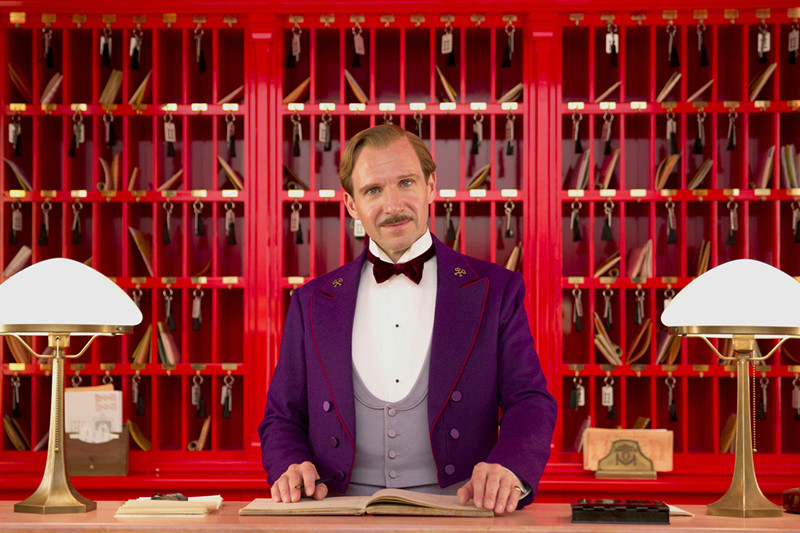
Gossamer-like, lovely and wistful, The Grand Budapest Hotel (2014) thrums with the dual dispositions of the sublime Golden Age director Ernst Lubitsch and the jam-packed chapter and verse of Stefan Zweig. In this calorie-rich and joyously effete film from writer-director Wes Anderson one will find his most exhaustive and exuberant picture to date.
The Grand Budapest Hotel exists in a baroque bubble of an imagined old Europe where period styles, historical allusions, and joyful generic conventions intersect amidst a seeming compendium of potential films of adventure, emotion, humor, hubris, and tragedy.
Certainly Anderson’s most intricate and all-inclusive film, it’s a highly flavored shaggy-dog confection that may also be his chef d’oeuvre. The following list details why it is that The Grand Budapest Hotel is such a joy to watch and why it will remain the jewel of a prominent director’s already distinctive body of work.
8. The Unconventional Screenplay
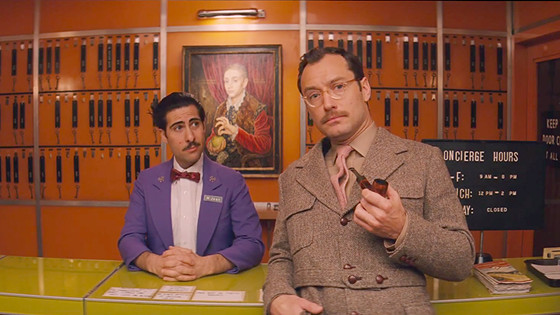
Anderson’s screenplay, which sprang from a story by Anderson and Hugo Guinness––both men shared nomination for the Academy Award for Best Original Screenplay for their considerable efforts––was largely influenced by adored Austrian novelist Stefan Zweig.
Divided over three different timelines (1985, 1968, and 1932) and with a gripping and grandiose story within a story within a story conceit, the film has, at its crux, Monsieur Gustave H. (Ralph Fiennes) as a concierge for the eponymous resort hotel. Paired with one of his employees, the young Zero Moustafa (Tony Revolori)––a character who we also meet in later life played by F. Murray Abraham––the duo must prove Gustave’s innocence after he’s been framed for murder by the jealous and nasty heirs of a family fortune.
With chapter breaks, intertitles, various narrators (some rather unreliable), and at times an almost dizzying parade of eccentric characters, locales, and endless time-skipping and nuance, The Grand Budapest Hotel bunny hops and trips the light fantastic at a feverish pace. The shaggy-dog digressions provide pratfalls, gags, dangers, and delicate flowering love in a literate, and edifyingly byzantine arrangement. The plot, while spreading in so many directions, maintains a kinetically fast pace and constant motion never lets up.
The dialogue is splashy, deliberate, and stylized, and this also means it’s unrealistic in many instances, but that’s the posturing, enraptured, and pleasant point of it all. The film is one of escapes and ecstasy, for the characters as well as the audience. So many ingredients are in this recipe that, while no doubt it will be too rich for some, will be an absolute delight, a favorite dish, for many.
7. The Hotel Itself
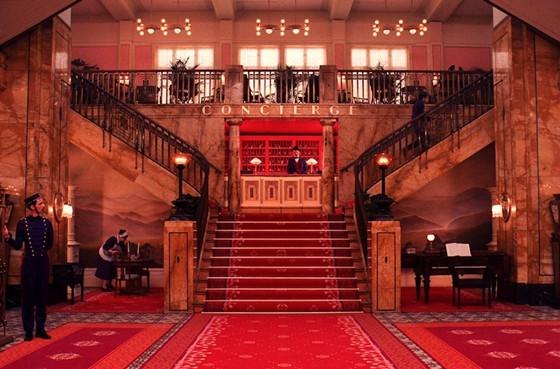
Much like the double sweet screenplay, the titular setting for the film, the Grand Budapest Hotel, is an opulent, overstuffed, and artful creation that pops with details.
The luxury hotel setting, and kudos aplenty go out to production designer Adam Stockhausen (Anna Pinnock designed the interiors, which we will discuss later in this list), comes from a long tradition of multi-protagonist comedies and melodramas in the old Hollywood tradition.
This tradition is exemplified best, perhaps, in Edmund Goulding’s sprawling 1932 drama Grand Hotel––it’s no coincidence that the main storyline in Anderson’s film is set also set in ‘32––wherein a huge ensemble cast embody overlapping lives in a bustling setting, creating its own subgenre of “grand hotel” films.
Running over with intricate designs and odd color combinations (pastel-pinks anyone?)––all Anderson hallmarks––a 10-feet-tall handmade miniature model was used in the wide shots to add an almost surreal and storybook element to the proceedings. The model used varying scales (it was 14 ft long and 7 ft deep), the richly detailed and tree-dotted hill on which it stood was a different scale, and last but not least, the foreground funicular railway was built to a third scale, each to capture it’s grandness as best cinematically speaking.
The interiors of the hotel, a cavernous and colorful den of detail and design work, contains within it the idiosyncratic gradation familiar to all of Anderson’s oeuvre––like the townhouse in The Royal Tenenbaums (2001) or the eponymous train from The Darjeeling Limited (2007)––and frequently matches the emotional lives of the personalities within it. Wow.
6. The Score by Alexandre Desplat
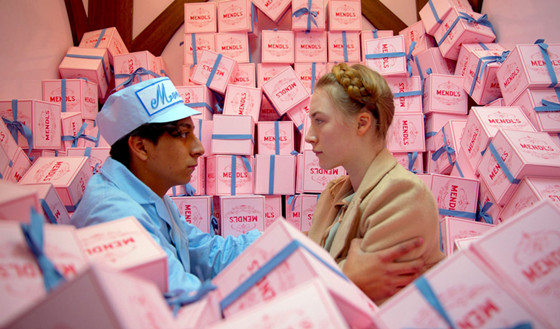
Like every one of Wes Anderson’s films before it, The Grand Budapest Hotel benefits immeasurably from the intensely suitable musical score. Having previously worked with Anderson on Fantastic Mr. Fox (2009) and Moonrise Kingdom (2012), Alexandre Desplat presents TGBH with a very balalaika (a 3-stringed Russian instrument with a characteristic triangular body) inspired soundscape.
Combined with church organs, and orchestral flourishes, the film has a central European vibe that manages to be both maudlin and melodic with a timeless ring to it. It’s no wonder that the Academy of Motion Picture Arts and Sciences awarded Desplat with the Oscar for Best Original Score.
5. The Fantastic Amount of Detail
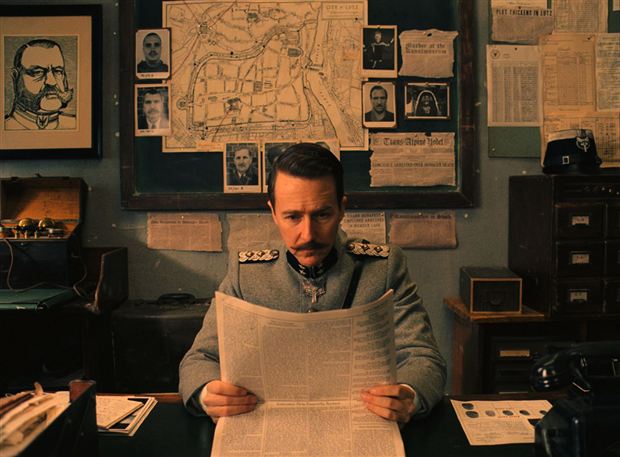
It was mentioned above that the hotel itself is opulent and overstuffed, popping with details to elaborate to immediately grasp in a single viewing, and this aesthetic demands to be applied to the entire film, without exception.
While Stockhausen presented much of the exterior and miniature work of the film, co-production designer Anna Pinnock deserves accolades for the labyrinthine levels of artistry within the eponymous inn. Both production designers shared the Oscar for Best Production Design, and they were hotly followed by Milena Canonero who won for Best Costume Design, and then Frances Hannon and Mark Coulier for Best Makeup and Hair, respectively.
All of these creatives brought Anderson’s elaborate, meticulous, and comprehensive fantasy world to vivid, shimmering life. Listing some of the many eye-candy delights starts to feel like a beat poetry exercise but lets chime off a few, noting that all these decadent visuals also contain surplus symbolism and theatrical elements that harken to Anderson’s genius: baths, birthmarks, confession booths, fussy uniforms, gondolas, graveyards, headstones, luxury automobiles, heavily tattooed prisoners, passports, pastries (oh the pastries!), motorcycles, mountain tops, oil paintings, perfume bottles, severed fingers, ski trails, train cars, trap doors, wine glasses and more.
TGBH is worth repeat viewings just to appreciate the point-by-point, precise, and often character-specific attention to detail throughout this swimming, swirling mandala-like motion picture experience.
4. The Shifting Aspect Ratios and Cinema Styles

As previously mentioned, TGBH unfolds over three distinct timelines and each is shot in three different ratios; 2.35:1, 1.85:1, and the classic 1.33:1. There’s a tangible Old Europe element that almost feels like Lubitsch, specifically his classic musical The Merry Widow (1934)––luxuriant in Old World flourishes from abroad.
There’s elements of gothic romance and mystery––Hitchcock’s The Lady Vanishes (1938) springs to mind––and with all the trap doors, secret passageways, evil assassins, and sketchy monks, not to mention the inspired inclusion of a secret society of hotel concierges, there’s nods to more Hitchcock (The 39 Steps and Notorious perhaps?) and British Secret Service/spy films à la Carol Reed.
Throw in some stop-motion sequences, a splash of kink, pastiches of American-style comedy of manners (“Holy shit, you got him!”), World War I espionage, romantic comedy, broad slapstick, elements of farce, and the feeling of peering into, who knows, Orson Welles toy box maybe? There’s so much stylistic variety––even a black and white melodramatic respite––that the eye and the mind never rest.
3. The Star-Studded Cast
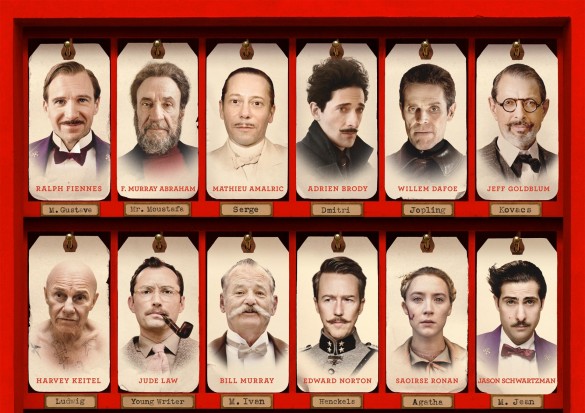
The large cast populating this storybook confection is hugely enjoyable, even if or perhaps because they exist on the periphery as colourful, sometimes larger than life apparitions with theatrical flourishes, colors, costumes and mannerisms.
Amongst the players, many hidden beneath layers of ornate and theatrical disguise, is Tilda Swinton’s elderly Madame D., Saoirse Ronan as Anna, Mathieu Amalric’s dubious Serge X., Harvey Keitel, Léa Seydoux, Fisher Stevens, and Lisa Kreuzer. And for the Anderson enthusiast it’s a delight to see his returning repertoire of performers, including Bob Balaban, Adrien Brody, Willem Dafoe, Bill Murray, Jason Schwartzman, Owen Wilson, and Wallace Wolodarsky amongst them.
While it’s true that some of the cast are only glimpsed briefly––as is the case with Balaban’s and Wilson’s concierge cameos––it certainly adds to the enjoyment and dizzying pace that the film expertly utilizes to sweep up the audience. Whew!
2. Ralph Fiennes’ Performance
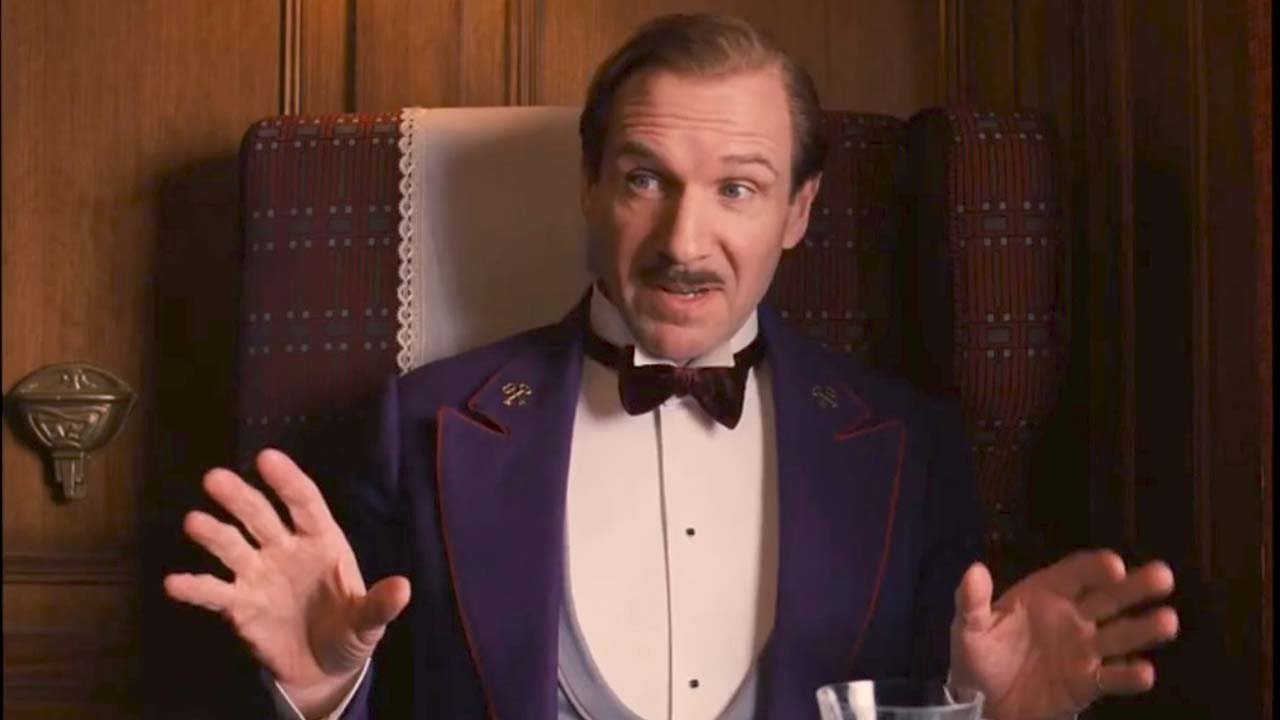
Ralph Fiennes shines as Monsieur Gustave H., not only leading the ensemble, he’s also the perfect, elegant intermediary; he serves the film much as he serves the hotel; attendant, comic foil, gigolo, host, protector, and stewart. His street-smarts, manipulative prowess, charisma, and suave serve him well and what is more, the complex and variegated role of Gustave gives Fiennes that all too rare a thing; a comedic role (but please note that the Coen Brothers beautifully utilized his comic chops in 2016’s hilarious Hail, Caesar!) .
From his love of very specific perfume––namely, the Pouilly-Jouvet ’26––to his yardbird candor (“Who’s got The Throat-Slitter?”), along with his protective paternal instincts (“Keep your hands off my lobby boy!”) and more, Fiennes continually outshines everyone else in the film––though perhaps his is the only character who really gets the reins to do so.
Fiennes’ faultless control, bold physicality, and perfect comic timing and delivery (“He’s responsible for the killing of Deputy Kovacs, Serge X and his club-footed sister, plus his own mother!”) adds up to one of his best ever performances, and perhaps it will signify the first of many collaborations with Anderson.
1. In Wes Anderson’s own words
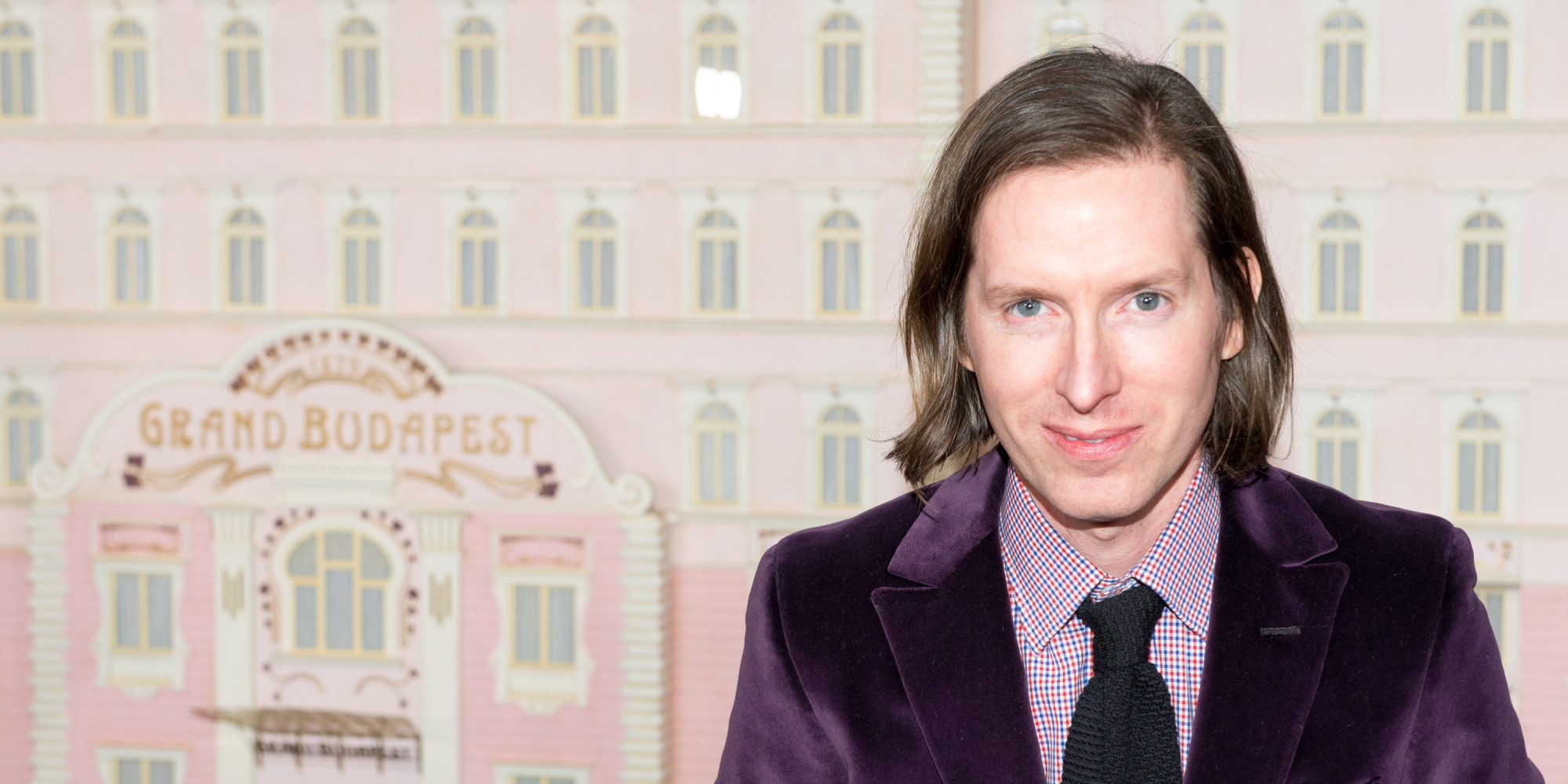
“I would think someone coming to [The Grand Budapest Hotel] fresh would just watch the movie,” Anderson says. “Maybe they would think: this is a little different from what I’ve seen before. But it is pretty straightforward storytelling, I think… I’ve done a bunch of movies. And it’s a luxury to me that they’re all whatever I’ve wanted them to be.”
While his critics and detractors may never warm to Anderson’s sweet-tooth cinema spoils, his fans have found in checking in to The Grand Budapest Hotel a highly stylized comedy smartly contrasted with melancholy, equalling his most exhaustive, integrated and delicious offering yet.
Author Bio: Shane Scott-Travis is a film critic, screenwriter, comic book author/illustrator and cineaste. Currently residing in Vancouver, Canada, Shane can often be found at the cinema, the dog park, or off in a corner someplace, paraphrasing Groucho Marx. Follow Shane on Twitter @ShaneScottravis.